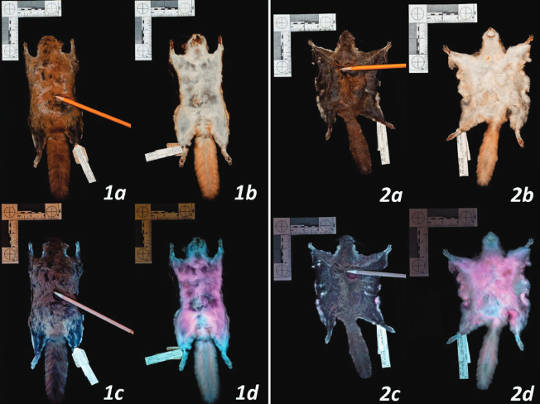This article was published in Scientific American’s former blog network and reflects the views of the author, not necessarily those of Scientific American
Flying squirrels already perform one famous trick: they’re born with a wingsuit and they know how to use it.
But now we have learned they possess another. Under UV light, they glow bubblegum pink.
On supporting science journalism
If you're enjoying this article, consider supporting our award-winning journalism by subscribing. By purchasing a subscription you are helping to ensure the future of impactful stories about the discoveries and ideas shaping our world today.

Photographs of Glaucomys sabrinus under visible light and 395 nm ultraviolet (UV) light. Credit: Kohler et al. 2019
This is particularly odd considering there are no other placental mammals that do. Sure, a few marsupials, including their continent-mates the Virginia opossum, also glow under fluorescent light. But in the world of placentals, lighting up like a coral reef is right out. Unless you’re a New World flying squirrel, apparently.
NWFS are found throughout North America. Three species, all related, ply their trade of foraging and gliding from dusk ‘til dawn from the Arctic Circle to the highlands of Honduras.
The discovery was made by a team from Northland College in Wisconsin and Texas A&M and published this winter in the Journal of Mammalogy. 108 of 109 museum specimens and all five wild animals they tested glowed with varying intensity, especially on their bellies. Why they glow, the scientists said, is less certain.
Flying squirrels are the only New World squirrels active at night, and they do not hibernate through the long winter months as many other squirrels do. As a result, they perpetually inhabit twilight or near-darkness. Remember the many glowing possums? They're also active at night.
During cool weather, flying squirrel activity tends to peak around sunrise and sunset. This is a time when UV intensity reaches a peak, but visible light is weak. In addition, fluorescent light is especially important for seeing in snow-covered landscapes. In winter, UV-B radiation is more prevalent relative to summer, and snow reflects UV radiation.
So it is likely that fluorescence makes squirrels more visible when they’re usually out and about, stashing nuts and raising hell. But to whom? And why?
The authors had a few ideas. First, fluorescence may make the squirrels more visible to other squirrels. Unlike the yellow UV-filtering lenses of New World squirrels active during the day, flying squirrels’ lenses are clear and capable of transmitting UV. When flying, their glowy underbellies are exposed and may alert other squirrels to their location or advertise their desirability as mates. Both uses of fluorescence have also been made by reef fish.
On the other hand, it may also make them more visible to predators in ways that deter them. Many owls that live around flying squirrels fluoresce pink or magenta. Gliding squirrels may be mimicking owls, attempting to throw predators off their (con)trails. Alternatively, they may be trying to blend in with fluorescent lichens on the bark of trees.
The forests in which they live, apparently, are alive with fluorescence, in spite of human obliviousness. In that respect, the nocturnal forest may be more like the nocturnal reef than we imagine. Next time I go on a night hike, I will be bringing along a black light.
Reference
Kohler, Allison M., Erik R. Olson, Jonathan G. Martin, and Paula Spaeth Anich. "Ultraviolet fluorescence discovered in New World flying squirrels (Glaucomys)." Journal of Mammalogy 100, no. 1 (2019): 21-30.